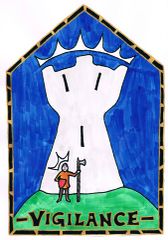Vigilance
The Path of Vigilance
The tired Beater stalking the Feni through the marshes of Bregasland. The band of Knights-errant with their eyes on the horizon, tracking the migration of a gryphon-pride through their lands. The scholarly magus, searching tome after tome by candlelight for the evidence she needs to convict a heretic. Vigilance is all of these things, and many more besides: it is the constant awareness that the dangers to the Empire are as twice as various as all its enemies, and the iron will needed to oppose it.
It is far more, though, than the huge, Empire-threatening concerns which make it as far as the printing presses. When danger presents itself, there must be someone ready to oppose it, yes – but Vigilance is also the complementary need to ensure that everything is safe. The scrivener who scrutinizes the records of his Dhomiro for evidence of fraud and theft, the shepherd who guards her sheep in the fields, the magister who carefully researches and documents every deal a particular Eternal has made with the Empire to search for patterns: though they may never find fraud, danger, wolves or hidden agendas, someone must ensure these things. It is said in Varushka that to assume that the vale is safe in the morning just because it was safe the night before is to put a knife to the throat of every person there.
More than any of the other Virtues, Vigilance demands constancy, and at times can be an unbearable strain to its adherents. Though it is credible and outwardly commendable for a Vigilant to literally never let her guard down, she must always be mindful of the dangers of seeing threats where there are none. Traditional theology is careful to guard against this, with a concept known by a number of names, most commonly “the Thwarting” or “the Ebb Tide” (both derived from old poems). Once a threat has been thwarted, the Vigilant should take time to relax and consolidate. A tired mind loses focus, after all, and focus is crucial.
Many followers of the Path of Vigilance embrace the importance of acting as part of a group; a guard alone must still sleep, eat or answer a call of nature. While they attend to the needs of their body, their post is unguarded. Two guards can ensure their post is never deserted; five guards can go further and ensure that their post is always held by someone who is alert and well-rested. Companions allow the Vigilant to maintain ready to face danger day and night without requiring constant expectation of threat.
Vigilance is popular among those charged with ensuring the safety of precious things, whether the Noble’s treasury, a mountain pass on the borders, the bounty and prosperity of a port-town, or the spiritual well-being of the Empire itself. To most citizens who are not charged with such duties, the most important thing is to know whom they can trust to report their suspicions to when troubled, and what they can do to help when help is asked of them.
The soul is the most precious thing that any human can possess, and some priests teach that it's protection is the highest calling that anyone can aspire to.
Guidance on the Path
Through study of the Paragons and Exemplars, the priests of The Way have gleaned insight into the heart of the Virtue and how best to pursue it. There are collections of parables, tales, sayings and teachings that distill this for Imperial Citizens to learn from. The following are a handful of teachings and sayings deemed to be essential to understanding the Path:
- Seek out the poison in your neighbour’s fields, lest your own crops be blighted.
- Be alert to all dangers; within and without.
- Seek out falsehood and expose the truth.
- Prepare for malice, yet thwart malice before it strikes against you.
- Despise that which threatens what you watch over, whether by malice, lies, folly or carelessness.
Paragons and Exemplars
Attempts to catalogue Paragons and Exemplars of Vigilance have met with mixed success. In some cases, the disaster they prevent or the catastrophe that goes averted results in their heroism going unsung. More notable are those who publicly expose traitors, infiltrators and black-hearted villains. Recognised Paragons and Exemplars of Vigilance include:
- The legendary Paragon known as The Sentinel is credited with building many ancient towers and fortresses that still stand today.
- The Paragon Vardas the Witch-Hunter of Varushka dedicated his life to tracking down and bringing to justice the criminals who preyed on his people.
Symbols, icons and trappings
The Path of Vigilance has many symbols across the Empire, but one of the most common is The Tower, which is symbolic not only of The Sentinel’s ancient works, but also epitomises the importance of defending what is precious, and in making the effort to prepare against threats. Along similar lines, another common symbol of the path is a Bell to symbolise the means of sounding a warning. Priests and Pilgrims of the Path of Vigilance will often carry a bell or whistle for precisely the purpose of alerting others to danger they have identified.
Further Reading
- You can learn about the various spiritual roleplaying effects created by priests dedicated to Vigilance here.
- You can learn about the skills that priests can use to safeguard the virtue of Vigilance here.
